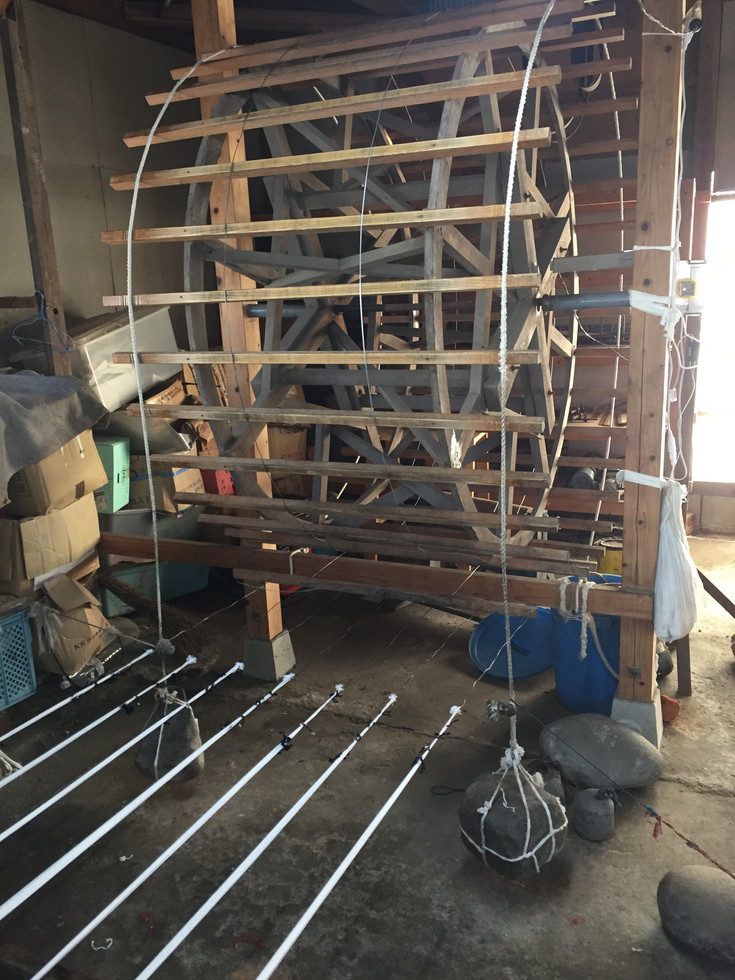30 steps 2 months: Story of the humble Kasuri textile
- Mikster

- May 25, 2019
- 4 min read
Updated: Jun 10, 2019

My Kyushu exploration led me to Yame City in Fukuoka Prefecture, most famous for Yame-cha (Yame green tea). I don't come here for the greens. I was out seeking to learn about a traditional textile call Kurume Kasuri (久留米絣). Kasuri is a modest resist-dyed cotton textile invented over 200 years ago by a very curious 12 year old girl named Inoue Den. The shibori dye method is applied to tied yarns where the dye-resisted strips create the pattern during weaving. (also known as ikat in India). Kurume kasuri was recognized as one of Japan's top 3 kasuri weave, and was named Japan's Intangible Cultural Heritage since the 50s.
This all started when I bought a pair of Men's gardening work-pants called "monpe" in Tokyo. I wore them to office occasionally with my other Nike attire. Monpe tapered-leg pants started as women gardening or work pants in the1940s, some said it was also worn as exercise uniform for air raid evacuation during wartime. You can imagine the fashion gossip I probably triggered. Having said that, they are 10 times more comfortable than my Nike tech pants. The more you wear and wash kasuri, the softer it gets. I do get occasional compliment for wearing the monpe (genuine or not). I may not be the most fashion forward, but hey, it's all about styling and "bringing back the silhouette"! :-) Nowadays, kasuri textile is associated to workers' clothing and old ladies' gardening or farming clothings. Comparable to Dickies and Carhartt in the US, but without the sub-culture fashion followers.
NO "KURUME KASURI" in KURUME?
I became curious about this cotton textile, and decided to set out to learn about it. Good that Japanese name their crafts after its city of origin, so I traveled to Kurume in Fukuoka Prefecture. After asking a few locals, I realized I will not find Kurume kasuri in Kurume. Manufacturers are all in Yame city (30 mins south of Kurume).
TOYOTA and KURUME KASURI
Ever since inventor Inoue started teaching her followers about this weave through hand looms, popularity of kasuri spread wide and fast and eventually turned into a full-scale manufacturing industry. Toyota actually started as mechanical loom inventor/engineer in the 1920s before they became a car manufacturer. At the height of the textile industry, there were over 100 factories in the area producing Kurume Kasuri. Currently, there are only 18 left, still running on old Toyota power looms.
At Shimogawa textile factory, 3rd generation owner Mr. Kyozo Shimogawa greeted me with the warmest welcome and toured me their factory. Rolls of loud, compact,100-year-old Toyota machines relentlessly churning out textiles of different colors and patterns.

Kasuri weaving involves over 30 steps from design, twine, dye, wash, dry, untwine, loom setting to weaving. Although automated, each step requires diligent attention and artisanal skills to maintain its high quality. In contrast to modern-day factory where one presses the button and let the machine and computer do the job, human skills and knowledge are INDISPENSABLE in every step of production of kasuri textile.
As we sat down, Mr. Shimogawa showed me some of the most difficult patterns they produced and talked about his vision of usage and overseas market. I am quite appalled to learned there is still very little acknowledgement of such high quality, utilitarian textile inside Japan.
Few days later, I returned to Yame city to meet with Mr. Kazuo Sakata, 3rd generation of Sakata Orimono textile factory. Kyushu hospitality is the BEST! Mr. Sakata spent time walking me through the production line from start to finish. The attention to details (by yarn) under the experienced hands of artisans breath life and precision into the beautiful textile. We also discussed the cost and price-point rationale about chemical dye vs natural dye. The signature "Japan Blue" natural indigo-dyed textile remains in production, though being reduced to only 1%. Next, Mr. Sakata showed me the co-op manufacturing plant where the wrapping and unwrapping machines are being shared by all textile factories. Although the power manufacturing process is almost a century old, one of the step did received a touch of modern technology, when pattern data gets feed into the wrapping machine via a laptop. I can only imagine that tedious process of wrapping / masking the yarn by hand prior dye process.
I got curious why the loom is so compact and why weave such narrow-width fabric. Mr. Sakata explained 36cm and 38cm are the standard panel sizes to make kimono. Traditionally a roll of kimono fabric "tanmono" has standard measurement of 12m x 38cm. As panels are cut to build a kimono, there will be no waste in fabric. The tailoring process is very different than western style clothing.
Kurume kasuri textile may have a humble beginning, but it definitely is more than grannies' and farm clothing material. With centuries of artisans' devotion in achieving perfection, and families like Sakata and Shimogawa's quests in continuing their family heritage, the cultural value of this quality material should be acknowledged. Though it has its limitation, but the potential for creative usage is unlimited. Calling all creative Designers, would you accept this challenge in reinventing this traditional textile and bring out its brilliance once again? Reach out and connect with us!
Last but not least, my heartfelt thanks to Mr. Shimogawa and Mr. Sakata for their great hospitality, sharing stories on their family heritage.


























Comments